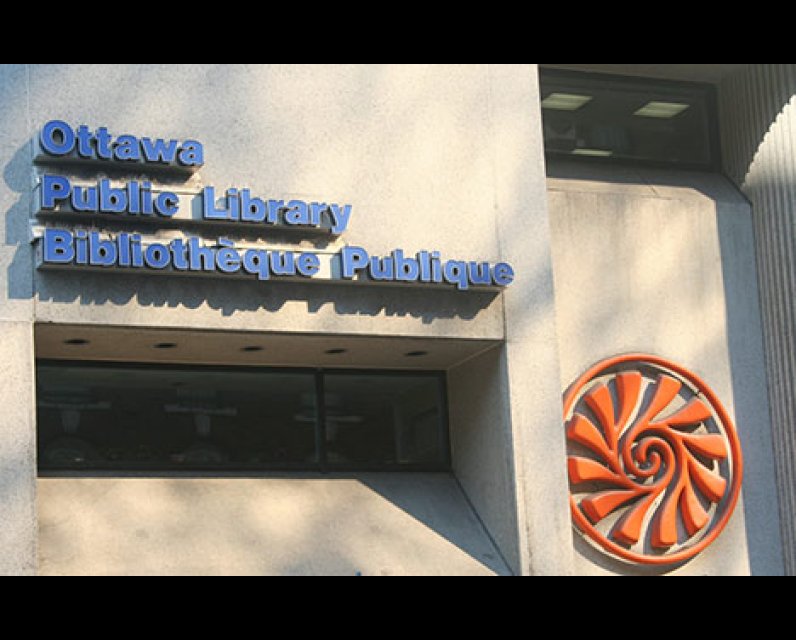Unpublished Opinions
A former federal civil servant (Foreign Affairs) and consultant, Terrence Lonergan lives in Ottawa and is active in local and community affairs.
A Modern Library for Ottawa (PART 2)

PART 2. The Modern Library Opens a Window into the Whole Written World
A day ago, I submitted to Unpublished Ottawa a first essay on Ottawa’s next Central Library. Today I deal with the second Paradox defining the Modern Library.
Paradox 2. In the future, libraries will store and display fewer books on their shelves that fewer people will borrow. Nevertheless their books business will grow, become more complex, and probably require more space.
It’s pretty safe to bet that future libraries will hold fewer books, at least in physical form. We can imagine a gradual process simply because any new book printed, even if there are fewer, adds up to an existing stock.
But process it will be. E-books will spread, even if slowly. And steadily, the libraries’ older volumes will become candidates for full digitization. Why indeed should anyone attempt to restore a dusty old tome when both text and illustrations can be preserved on a computer hard disk or memory chip?
Digitization offers other advantages. It takes only one full digital copy per title to serve every member of the public and that copy will be stored invisibly as bits and bytes rather than take up one or two inches of shelf space.
To be sure, the librarians will want to retain part of the collection, for its artistic merits, historical value or rarity. It is also possible that new copies of beautiful or high quality books will be reproduced as art objects (with high quality printers or bound the old-fashioned way). A New library will want to set aside sufficient space for this activity (the OPL Board calls “Maker-Space” this type of arts and crafts room).
As digitization expands, the likelihood of finding a public domain book in hard or soft copy will disappear, and so to will, one by one, the bookcases that today line just about every library wall. (In Canada, copyright normally expires only 50 years after the death of its author).[i]
In a nutshell, when it comes to space, digitization will probably consume more space than it saves. Think of it as a trifecta:
a) The digital age management of books (paper and virtual) is equipment-intensive. Any library built today must be plugged-in, i.e. offer free broadband Wi-Fi, provide numerous computer workstations, use radio-frequency book tags (RFIDs) and other computerized systems for every aspect of book management, and have its walls, floors and ceilings criss-crossed by a full network of cables, preferably fibre-optic. These machines and infrastructure all demand additional, carefully laid out space, where rooms are sectioned off into small, quiet and no so quiet, zones.
b) Digitization and physical reproduction are simple enough procedures, but they demand an adequate supply of resources such as time, labour, and specialized equipment (plus of course books and other documents. They must also be present). These new activities will require a fair amount of space.
c) Fill it up to the rafters with books, it doesn’t matter; even the biggest traditional library eventually runs out of space. The digital library, on the other hand, can theoretically house a copy of all the books in the world. Seen from this perspective, the Modern Library acquires new and immense value, sufficient to attract a larger number of users, each in need of chair, table, workstation and space.
My third point may sound bold, so I will dwell on it.
When the United States Congress established its Library, in 1800, it decided it would contain containing "such books as may be necessary for the use of Congress…”. From the outset the Library gave this definition the widest, most inclusive definition. In 1870, as the institution responsible for implementation of the copyright law, the library required all copyright applicants to send to the Library two copies of their work. This resulted in a flood of books, pamphlets, maps, music, prints, and photographs, which has continued undiminished until today.
Today's Library of Congress (LOC) is an unparalleled world resource. The collection of more than 158 million items includes more than 36 million catalogued books and other print materials in 460 languages; more than 69 million manuscripts; the largest rare book collection in North America; and the world's largest collection of legal materials, films, maps, sheet music and sound recordings.[ii]
Such staggering numbers long fed the belief that the Library of Congress had set a standard impossible to emulate, so unique as to be aberrant.
However, the LOC’s unreachable star fell out of the sky when digitization and the Internet turned this world on its head. In 2015, any computer, tablet or smart phone can plug in to a database equivalent in size or ever larger than the LOC collection.
Which raises two good questions:
- Why should any library, even the LOC, endeavour to become an electronic vault for books, pamphlets, maps, music, prints, photographs or anything else? Doesn’t the Internet already contain them all?
- If a Universal Public Library (UPL) were such a good idea, why haven’t libraries already combined resources, digitized their respective collections and created this super-library network?
The answer to the first question has to do with order, accessibility and preservation.
The Internet is essentially chaotic with bits and pieces of book collections all over the place. In the absence of thematic or functional organisation, of central repositories, or website catalogues, unguided navigation from one source of information to the next is the only way to explore an almost infinite domain.
In addition, existence does not imply access. Google-books answered my query about ‘libraries in the information age’ with 1,590,000 results in 0.40 seconds and instructions on where to rent or buy the books I was interested in. I was not surprised since I had been looking for books written in this generation and therefore still subject to copyright.
Finally, all the information on the Internet is ephemeral. There is no guarantee that the website I visited today will still be up at my next visit. With good reason, the Internet is described as a wave (and our activity called surfing). The Web offers a huge, awesome, slice of the present moment. It has created no memory of its past; it cannot envision, let alone plan, a future for the information it contains. The Internet is space without time. As it now exists it is a gigantic sand castle.
That’s a thought that should trouble us. A society is wise to protect the knowledge it has accumulated, wiser still to make this knowledge as widely accessible as possible, in forms and formats that are as endurable as possible.
The answer to question 2, unfortunately has to do with habit and inertia. Furrows are great for growing seeds into wheat, deadly for creative thinking. In 2004, when Google presented its ‘Google Books Library Project’ to the world’s greatest libraries, it met with either opposition or acquiescence. It never encountered meaningful competition.
That was 10 years ago. It’s now high time for public libraries to wake up. In 2015 the task of digitizing existing public book collections and creating a common and fully accessible mega-collection among public libraries can no longer be postponed. If we want Ottawa’s new Central Branch to live up to its billing, and to play a real role in our lives, we must right from the start design it as a 21st century institution.
Terrence Lonergan
Ottawa
--------------------------
[i] The full text of Canada’s Copyright Act may be found at: http://laws- lois.justice.gc.ca/eng/acts/C-42/Index.html. Article 30 stipulates the terms that apply to Libraries, Archives and Museums.
[ii] Source Library of Congress : http://www.loc.gov/about/history-of-the-library/, accessed 18 March 2015.
-------------------------
A Modern Library for Ottawa:
- PART 1. The Modern Library is also a Community Centre
- PART 3. The Modern Library is a Gateway to Total Reading
- PART 4. The Modern Library is also a Knowledge Factory
- PART 5. Ottawa's New Central Library: What for? What like? Where?



Comments
Be the first to comment